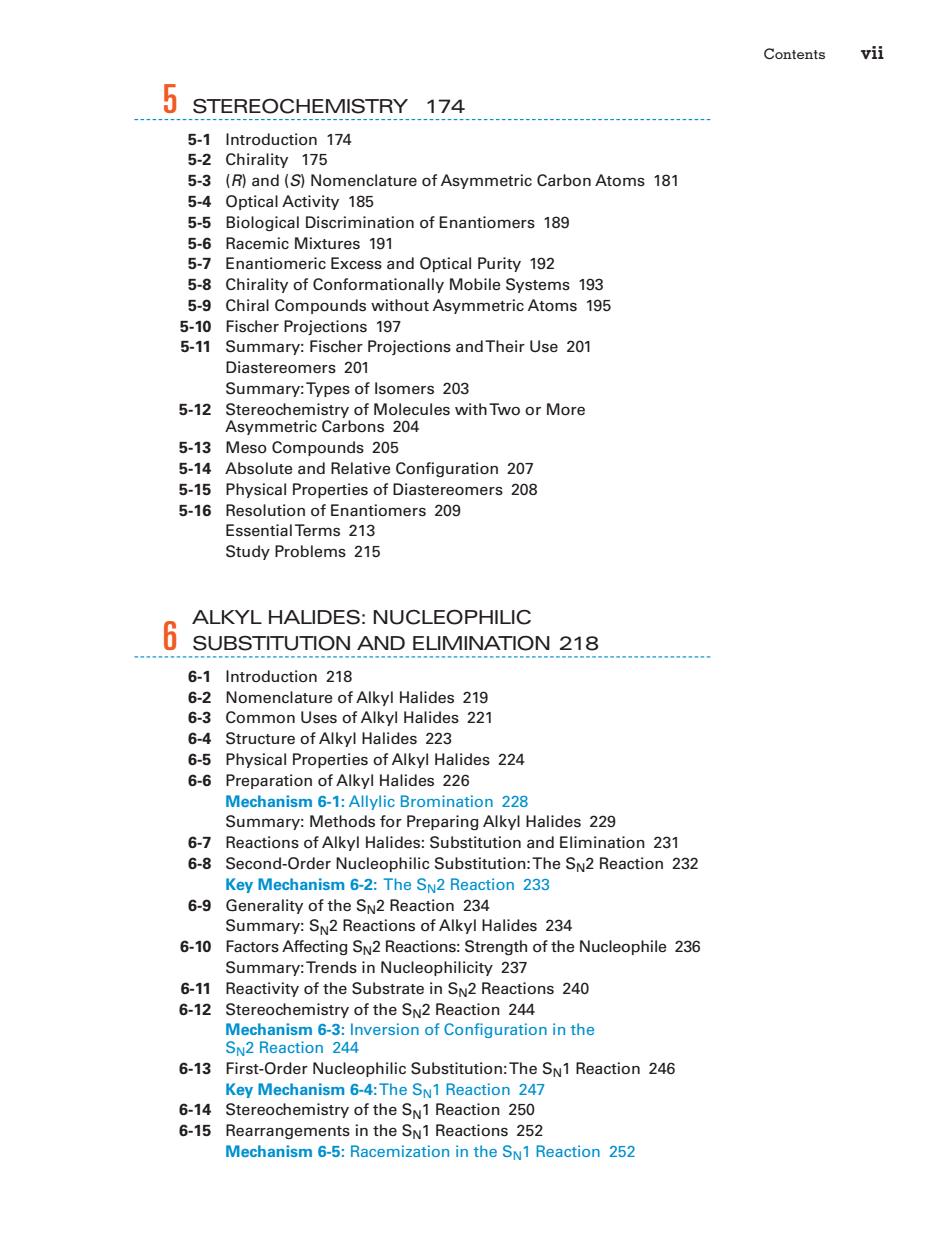正在加载图片...

Contents vii 5STEREOCHEMISTRY174 5-1 Introduction 174 5-2 Chirality 175 5-3 (R)and(S)Nomenclature of Asymmetric Carbon Atoms 181 5-4 Optical Activity 185 5-5 Biological Discrimination of Enantiomers 189 5-6 Racemic Mixtures 191 5-7 Enantiomeric Excess and Optical Purity 192 5-8 Chirality of Conformationally Mobile Systems 193 5-9 Chiral Compounds without Asymmetric Atoms 195 5-10 Fischer Projections 197 5-11 Summary:Fischer Projections andTheir Use 201 Diastereomers 20 Summary:lypes o me 20 5-12 ules with Two or More 20 5-13 Meso Compounds 205 5-14 Absolute and Relative Configuration 207 5-15 Physical pronerties of diastereomers 208 5.16 Resolution of Enantiomers 209 Essential Terms 213 Study Problems 215 ALKYL HALIDES:NUCLEOPHILIC 6 SUBSTITUTION AND ELIMINATION 218 Introduction 218 ommon Usp kyl Hali kyl Ha 6.5 6-6 rope lides 224 d Halid s22 6-1:Allylic Summ ds for Alkyl Halides 229 6.7 s of alkyl Halides .c. ituti and Eli tion 231 6-8 Second order Nu cleophilic Substitution:The S2 Reac tion 232 Key Mechanism 6-2:The SN2 Reaction 233 6-9 generality of the sn2 reaction 234 Summary:SN2 Reactions of Alkyl Halides 234 6-10 Factors Affecting SN2 Reactions:Strength of the Nucleophile 236 Summary:Trends in Nucleophilicity 237 6-11 Reactivity of the substrate in s2 reactions 240 6-12 Stereochemistry of the SN2 Reaction 244 Mech anism 6-3: nversion of Configuration in the 6-13 ophilic Substitution:The SN1 Reaction 246 e A. on 6-14 6-15 the 25 65.R Reaction 252Contents vii 5 STEREOCHEMISTRY 174 5-1 Introduction 174 5-2 Chirality 175 5-3 (R) and (S) Nomenclature of Asymmetric Carbon Atoms 181 5-4 Optical Activity 185 5-5 Biological Discrimination of Enantiomers 189 5-6 Racemic Mixtures 191 5-7 Enantiomeric Excess and Optical Purity 192 5-8 Chirality of Conformationally Mobile Systems 193 5-9 Chiral Compounds without Asymmetric Atoms 195 5-10 Fischer Projections 197 5-11 Summary: Fischer Projections and Their Use 201 Diastereomers 201 Summary: Types of Isomers 203 5-12 Stereochemistry of Molecules with Two or More Asymmetric Carbons 204 5-13 Meso Compounds 205 5-14 Absolute and Relative Configuration 207 5-15 Physical Properties of Diastereomers 208 5-16 Resolution of Enantiomers 209 Essential Terms 213 Study Problems 215 6 ALKYL HALIDES: NUCLEOPHILIC SUBSTITUTION AND ELIMINATION 218 6-1 Introduction 218 6-2 Nomenclature of Alkyl Halides 219 6-3 Common Uses of Alkyl Halides 221 6-4 Structure of Alkyl Halides 223 6-5 Physical Properties of Alkyl Halides 224 6-6 Preparation of Alkyl Halides 226 Mechanism 6-1: Allylic Bromination 228 Summary: Methods for Preparing Alkyl Halides 229 6-7 Reactions of Alkyl Halides: Substitution and Elimination 231 6-8 Second-Order Nucleophilic Substitution: The SN2 Reaction 232 Key Mechanism 6-2: The SN2 Reaction 233 6-9 Generality of the SN2 Reaction 234 Summary: SN2 Reactions of Alkyl Halides 234 6-10 Factors Affecting SN2 Reactions: Strength of the Nucleophile 236 Summary: Trends in Nucleophilicity 237 6-11 Reactivity of the Substrate in SN2 Reactions 240 6-12 Stereochemistry of the SN2 Reaction 244 Mechanism 6-3: Inversion of Configuration in the SN2 Reaction 244 6-13 First-Order Nucleophilic Substitution: The SN1 Reaction 246 Key Mechanism 6-4:The SN1 Reaction 247 6-14 Stereochemistry of the SN1 Reaction 250 6-15 Rearrangements in the SN1 Reactions 252 Mechanism 6-5: Racemization in the SN1 Reaction 252